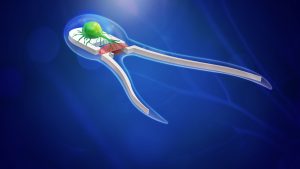Biological machines
Industrial revolution of the 19th century marked the onset of the era of machines that transformed societies. However, these machines cannot self-assemble, self-heal, or have inherent intelligence. On the other hand, since the discovery of genes, there is a considerable body of knowledge on engineering living cells. We thus envision future when soft robots will consist of living cells. They will emerge (self-evolve) through interactions between the cells (e.g., neurons, muscles) and engineered scaffolds. These machines have the potential of unprecedented capabilities, as they would carry the footprints of millions of years of evolution. We have demonstrated an autonomous biohybrid swimmer consisting of heart cells and a micro-mechanical flagellum (MEMS structure). Here, the heart cells, placed randomly on the flagellum, self-organize and synchronize their beating by interacting with each other and the soft flagellum. Through these interactions emerges a sperm like swimmer that swims autonomously (video above, Nature Communications, 5, Article number 3081, Jan 17, 2014, doi:10.1038/ncomms4081).
More recently, we demonstrated a biohybrid swimmer propelled by self-assembled muscle tissue, stimulated by neurons (image below, PNAS, 116 (40) 19841-19847, 2019, DOI: 1073/pnas.1907051116). Here, neurons interact with one another forming a network, muscle cells cooperate with each other to form muscle tissue, neurons interact with the muscle tissue to form neurons-muscular junctions to stimulate the muscle and drive the swimmer. These are the first demonstrations of a biohybrid robots emerging from randomly placed cells through hierarchical and complex interactions. We believe, future robots will evolve through such disorder-to-order transitions – a new paradigm for biohybrid machines. We are currently exploring (1) the principles of interaction between cells guided by biophysical microenvironment, (2) advanced biohybrid robots interfaced with flexible electronics, and (3) memory, learning and intelligence in neuro-muscular robots.

